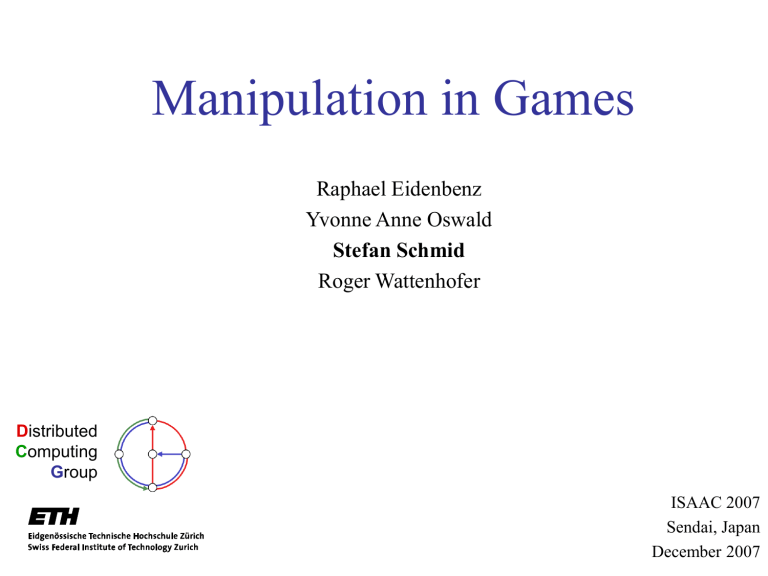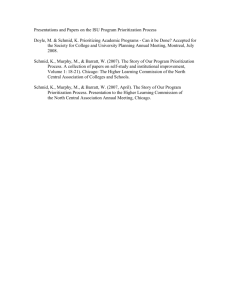Slides as PPT

D istributed
C omputing
G roup
Manipulation in Games
Raphael Eidenbenz
Yvonne Anne Oswald
Stefan Schmid
Roger Wattenhofer
ISAAC 2007
Sendai, Japan
December 2007
D istributed
C omputing
G roup
Manipulation in Games also present at the conference
Raphael Eidenbenz
Yvonne Anne Oswald
Stefan Schmid
Roger Wattenhofer
ISAAC 2007
Sendai, Japan
December 2007
D istributed
C omputing
G roup
Manipulation in Games also present at the conference
Raphael Eidenbenz
Yvonne Anne Oswald
Stefan Schmid
Roger Wattenhofer
ISAAC 2007
Sendai, Japan
December 2007
Extended Prisoners’ Dilemma (1)
• A bimatrix game with two bank robbers
A bank robbery (unsure, video tape ) and a minor crime (sure, DNA )
- Players are interrogated independently
Robber 1 silent testify confess silent
3 3
4 0
0 0
Robber 2 testify
0 4
1 1
0 0 confess
0 0
0 0
0 0
Stefan Schmid @ ISAAC 2007 4
Extended Prisoners’ Dilemma (2)
• A bimatrix game with two bank robbers
Robber 1 silent testify confess silent
3 3
4 0
0 0
Robber 2 testify
0 4
1 1
0 0 confess
0 0
0 0
0 0
Payoff = number of saved years in prison
Silent = Deny bank robbery
Testify = Betray other player (provide evidence of other player‘s bankrobbery)
Confess = Confess bank robbery (prove that they acted together)
Stefan Schmid @ ISAAC 2007 5
Extended Prisoners’ Dilemma (3)
• Concept of non-dominated strategies
Robber 1 silent testify confess silent
3 3
4 0
0 0
Robber 2 testify
0 4
1 1
0 0 confess
0 0
0 0
0 0 dominated by „testify“ non-dominated strategy dominated by „silent“ and „testify“ non-dominated strategy profile
• Non-dominated strategy may not be unique !
• In this talk, we use weakest assumption that players choose any non-dominated strategy. (here: both will testify)
Stefan Schmid @ ISAAC 2007 6
Mechanism Design by Al Capone (1)
• Hence: both players testify = go 3 years to prison each .
Robber 1 silent testify confess silent
3 3
4 0
0 0
Robber 2 testify
0 4
1 1
0 0 confess
0 0
0 0
0 0
• Not good for gangsters‘ boss Al Capone !
- Reason: Employees in prison!
- Goal: Influence their decisions
- Means: Promising certain payments for certain outcomes!
Stefan Schmid @ ISAAC 2007 7
Mechanism Design by Al Capone (2)
s t c s
3 3
4 0
0 0 t
0 4
1 1
0 0 c
0 0
0 0
0 0
Original game G ...
c s
1 1
0 2 t
2 0
+ ... plus Al Capone‘s monetary promises V ... s t c
= ... yields new game G(V) !
s t c s
4 4
4 2
0 0
New non-dominated strategy profile !
Al Capone has to pay money worth 2 years in prison, but saves
4 years for his employees!
Net gain: 2 years!
t
2 4
1 1
0 0 c
0 0
0 0
0 0
Stefan Schmid @ ISAAC 2007 8
Al Capone can save his employees 4 years in prison at low costs!
Can the police do a similar trick to increase the total number of years the employees spend in prison?
Stefan Schmid @ ISAAC 2007 9
Mechanism Design by the Police
s t c s
3 3
4 0
0 0 t
0 4
1 1
0 0 c
0 0
0 0
0 0
Original game G ...
s t
+ ... plus the police‘ monetary promises V ... s t c 5 0 2 0 c
0 5
0 2
= ... yields new game G(V) !
s t c s
3 3
4 0
5 0
New non-dominated strategy profile!
Both robbers will confess and go to jail for four years
each! Police does not have to pay anything at all!
Net gain: 2 t
0 4
1 1
2 0 c
0 5
0 2
0 0
Stefan Schmid @ ISAAC 2007 10
Definition:
Strategy profile implemented by Al Capone has leverage (potential) of two: at the cost of money worth 2 years in prison, the players in the game are better off by 4 years in prison.
Strategy profile implemented by the police has a malicious leverage of two: at no costs, the players are worse off by 2 years.
Stefan Schmid @ ISAAC 2007 11
• Paper studies the leverage in games = extent to which the players‘ decisions can be manipulated by creditability
- Creditability = the promise of money
• For both benevolent as well as malicous mechanism designers
Benevolent = improve players‘ situation (i.e., increase social welfare)
- Malicious = make their situation worse!
Stefan Schmid @ ISAAC 2007 12
Talk Overview
• Definitions and Models
• Overview of Results
• Sample result: NP-hardness
• Discussion
Stefan Schmid @ ISAAC 2007 13
Talk Overview
• Definitions and Models
• Overview of Results
• Sample result: NP-hardness
• Discussion
Stefan Schmid @ ISAAC 2007 14
Exact vs Non-Exact (1)
• Goal of a mechanism designer: implement a certain set of strategy profiles at low costs
- I.e., make this set of profiles the (newly) non-dominated set of strategies
• Two options: Exact implementation and non-exact implementation
- Exact implementation : All strategy profiles in the target region O are non-dominated
- Non-exact implementation : Only a subset of profiles in the target region
O are non-dominated
Stefan Schmid @ ISAAC 2007 15
Exact vs Non-Exact (2)
Player 2
Game G
X*
X*(V)
X* = non-dominated strategies before manipulation
X*(V) = non-dominated strategies after manipulation
Exact implementation:
X*(V) = O
Non-exact implementation:
X*(V) ½ O
Non-exact implementations can yield larger gains, as the mechanism designer can choose which subsets to implement!
Stefan Schmid @ ISAAC 2007 16
Worst-Case vs Uniform Cost
• What is the cost of implementing a target region O ?
• Two different cost models: worst-case implementation cost and uniform implementation cost
- Worst-case implementation cost: Assumes that players end up in the worst (most expensive) non-dominated strategy profile.
- Uniform implementation costs: The implementation costs is the average of the cost over all non-dominated strategy profiles. (All profiles are equally likely.)
Stefan Schmid @ ISAAC 2007 17
Talk Overview
• Definitions and Models
• Overview of Results
• Sample result: NP-hardness
• Discussion
Stefan Schmid @ ISAAC 2007 18
Talk Overview
• Definitions and Models
• Overview of Results
• Sample result: NP-hardness
• Discussion
Stefan Schmid @ ISAAC 2007 19
Overview of Results
• Worst-case leverage
- Polynomial time algorithm for computing leverage of singletons
- Leverage for special games (e.g., zero-sum games)
- Algorithms for general leverage (super polynomial time)
• Uniform leverage
- Computing minimal implementation cost is NP -hard (for both exact and non-exact implementations); it cannot be approximated better than
(n ¢ log(|X i
*\O i
|))
- Computing leverage is also NP -hard and also hard to approximate .
- Polynomial time algorithm for singletons and super-polynomial time algorithms for the general case.
Stefan Schmid @ ISAAC 2007 20
Talk Overview
• Definitions and Models
• Overview of Results
• Sample result: NP-hardness
• Discussion
Stefan Schmid @ ISAAC 2007 21
Talk Overview
• Definitions and Models
• Overview of Results
• Sample result: NP-hardness
• Discussion
Stefan Schmid @ ISAAC 2007 22
Sample Result: NP-hardness (1)
Theorem: Computing exact uniform implementation cost is NP-hard.
• Reduction from Set Cover : Given a set cover problem instance, we can efficiently construct a game whose minimal exact implementation cost yields a solution to the minimal set cover problem.
• As set cover is NP -hard, the uniform implementation cost must also be NP -hard to compute.
Stefan Schmid @ ISAAC 2007 23
Sample Result: NP-hardness (2)
• Sample set cover instance: universe of elements U = {e
1
,e
2
,e
3
,e
4
,e
5
} universe of sets S = {S
1
, S
2
, S
3
,S
4
} where S
1
= {e
1
,e
4
} , S
2
={e
2
,e
4
} , S
3
={e
2
,e
3
,e
5
} , S
4
={e
1
,e
2
,e
3
}
• Gives game...: elements helper cols elements sets
Stefan Schmid @ ISAAC 2007
Player 2 : payoff 1 everywhere except for column r (payoff 0)
Also works for more than two players!
24
Sample Result: NP-hardness (3)
All 5s (=number of elements) in diagonal...
Stefan Schmid @ ISAAC 2007 25
Sample Result: NP-hardness (3)
Stefan Schmid @ ISAAC 2007
Set has a 5 for each element it contains...
(e.g., S
1
= {e
1
,e
4
})
26
Sample Result: NP-hardness (3)
O
Stefan Schmid @ ISAAC 2007
Goal: implementing this region O exactly at minimal cost
27
Sample Result: NP-hardness (3)
X*
Originally, all these strategy profiles are non-dominated...
Stefan Schmid @ ISAAC 2007 28
Sample Result: NP-hardness (3)
Stefan Schmid @ ISAAC 2007
It can be shown that the minimal cost implementation only makes 1-payments here ...
In order to dominate strategies above, we have to select minimal number of sets which covers all elements!
(minimal set cover)
29
Sample Result: NP-hardness (3)
1
1
1
Stefan Schmid @ ISAAC 2007
A possible solution:
S
2
, S
3
, S
4
„dominates“ or
„covers“ all elements above!
Implementation costs: 3
30
Sample Result: NP-hardness (3)
1
1
Stefan Schmid @ ISAAC 2007
A better solution: cost 2!
31
Sample Result: NP-hardness (4)
• A similar thing works for non-exact implementations!
• From hardness of costs follows hardness of leverage !
Stefan Schmid @ ISAAC 2007 32
Talk Overview
• Definitions and Models
• Overview of Results
• Sample result: NP-hardness
• Discussion
Stefan Schmid @ ISAAC 2007 33
Talk Overview
• Definitions and Models
• Overview of Results
• Sample result: NP-hardness
• Discussion
Stefan Schmid @ ISAAC 2007 34
Discussion
• Both benevolent and malicious mechanism designers can influence the outcome of games at low costs (sometimes even if they are bankrupt !)
• Finding the leverage (or potential) of desired regions is often computationally hard .
• Many interesting threads for future research!
NP -hardness for worst-case implementation cost?
Approximation algorithms for costs and leverage?
- Mixed (randomized) strategies?
- Test in practice?
Stefan Schmid @ ISAAC 2007 35
Thank you for your interest!
Stefan Schmid @ ISAAC 2007 36
Extra Slides…
Stefan Schmid @ ISAAC 2007 37
Q&A (1)
• Assumptions
Players do not know about other players‘ payoffs.
Choice of non-dominated strategies: weakest reasonable assumption
Alternatives: Nash equilibria (NEs can be outside „non-dominated region“, but not a meaningful solution concept for „one shot games“ => implementing a good NE could be a goal for the designer as players will remain with their choices!), dominant strategies (do not always exist? => could be goal of mechanism though !!), etc.
Nash Equlibria
• Worst-case leverage?
Hardness more difficult: Only one profile counts! No easy reduction from Set Cover.
But maybe SAT ? -> See Monderer and Tennenholtz!
• Related Work?
Monderer and Tennenholtz: „k-Implementation“. EC 2003
Eidenbenz, Oswald, Schmid, Wattenhofer: „Mechanism Design by Creditability“.
COCOA 2007
Stefan Schmid @ ISAAC 2007 38
Q&A (2)
• Exact hardness -> non-exact hardness?
Non-exact implementation might be cheaper and look different! (cannot prove that payments are only „1“s in that column)
Need other game!
• Potential of Entire Games
I.e.: No goal of what the players do, just maximize / minimize overall efficiency / potential
Our algorithms also applicable! Exact case however needs extra column. Exact interesting?
NP-hardness proof may not hold for these special Os! (In our reduction, O is only subset!)
• Malicious Mechanism Designer?
Initial motivation: Monderer et al. only gave „positive example“, kind of „ insurance “; but also works here!
• COCOA Results
No notion of potential: Only implementation cost, does not consider gain !
Characterization of 0-implementable games (e.g., Nash equilibria)
Algorithms for cost (exact ones and heuristics)
Error in Monderer et al.‘s hardness proof
Other models of players‘ rationality, e.g., risk-averse
Dynamic games
Stefan Schmid @ ISAAC 2007 39
Q&A (3)
• Monderer and Tennenholtz, EC 2003
K-implementation
Complete information and incomplete information games (combinatorial auction / VCG games), including study of mixed strategies
Complete information (our model!): Polynomial time algo for exact costs, and NP-hardness proof for non-exact case (wrong)
Incomplete information = Mechanism designer does not see players‘ types!
Stefan Schmid @ ISAAC 2007 40
Definitions
Stefan Schmid @ ISAAC 2007
Subtracted twice, as money spent on players is considered a loss!
41
Algorithms
Stefan Schmid @ ISAAC 2007 42
O Wins (Worst-case Cost)
• Sometimes implementing a singleton is not optimal!
- Exact implementation costs 2, for all possible outcomes
- Singleton is more expensive: e.g., profile (3,1) costs
1 (Player 1) + 10 (Player 2), but new social welfare is the same as in exact case!
Stefan Schmid @ ISAAC 2007 43
Authors at Conference...
Yvonne Anne
Oswald
Raphael
Eidenbenz
Stefan Schmid @ ISAAC 2007
Stefan
Schmid
44







